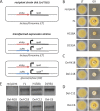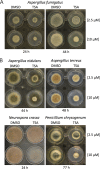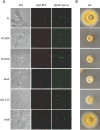A Class 1 Histone Deacetylase with Potential as an Antifungal Target
- PMID: 27803184
- PMCID: PMC5090035
- DOI: 10.1128/mBio.00831-16
A Class 1 Histone Deacetylase with Potential as an Antifungal Target
Abstract
Histone deacetylases (HDACs) remove acetyl moieties from lysine residues at histone tails and nuclear regulatory proteins and thus significantly impact chromatin remodeling and transcriptional regulation in eukaryotes. In recent years, HDACs of filamentous fungi were found to be decisive regulators of genes involved in pathogenicity and the production of important fungal metabolites such as antibiotics and toxins. Here we present proof that one of these enzymes, the class 1 type HDAC RpdA, is of vital importance for the opportunistic human pathogen Aspergillus fumigatus Recombinant expression of inactivated RpdA shows that loss of catalytic activity is responsible for the lethal phenotype of Aspergillus RpdA null mutants. Furthermore, we demonstrate that a fungus-specific C-terminal region of only a few acidic amino acids is required for both the nuclear localization and catalytic activity of the enzyme in the model organism Aspergillus nidulans Since strains with single or multiple deletions of other classical HDACs revealed no or only moderate growth deficiencies, it is highly probable that the significant delay of germination and the growth defects observed in strains growing under the HDAC inhibitor trichostatin A are caused primarily by inhibition of catalytic RpdA activity. Indeed, even at low nanomolar concentrations of the inhibitor, the catalytic activity of purified RpdA is considerably diminished. Considering these results, RpdA with its fungus-specific motif represents a promising target for novel HDAC inhibitors that, in addition to their increasing impact as anticancer drugs, might gain in importance as antifungals against life-threatening invasive infections, apart from or in combination with classical antifungal therapy regimes.
Importance: This paper reports on the fungal histone deacetylase RpdA and its importance for the viability of the fungal pathogen Aspergillus fumigatus and other filamentous fungi, a finding that is without precedent in other eukaryotic pathogens. Our data clearly indicate that loss of RpdA activity, as well as depletion of the enzyme in the nucleus, results in lethality of the corresponding Aspergillus mutants. Interestingly, both catalytic activity and proper cellular localization depend on the presence of an acidic motif within the C terminus of RpdA-type enzymes of filamentous fungi that is missing from the homologous proteins of yeasts and higher eukaryotes. The pivotal role, together with the fungus-specific features, turns RpdA into a promising antifungal target of histone deacetylase inhibitors, a class of molecules that is successfully used for the treatment of certain types of cancer. Indeed, some of these inhibitors significantly delay the germination and growth of different filamentous fungi via inhibition of RpdA. Upcoming analyses of clinically approved and novel inhibitors will elucidate their therapeutic potential as new agents for the therapy of invasive fungal infections-an interesting aspect in light of the rising resistance of fungal pathogens to conventional therapies.
Copyright © 2016 Bauer et al.
Figures








Comment in
-
Antifungals: Uncovering new drugs and targets.Nat Rev Microbiol. 2017 Jan;15(1):1. doi: 10.1038/nrmicro.2016.179. Epub 2016 Nov 21. Nat Rev Microbiol. 2017. PMID: 27867200 No abstract available.
References
MeSH terms
Substances
Grants and funding
LinkOut - more resources
Full Text Sources
Other Literature Sources

